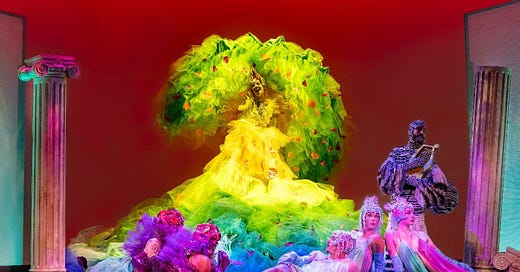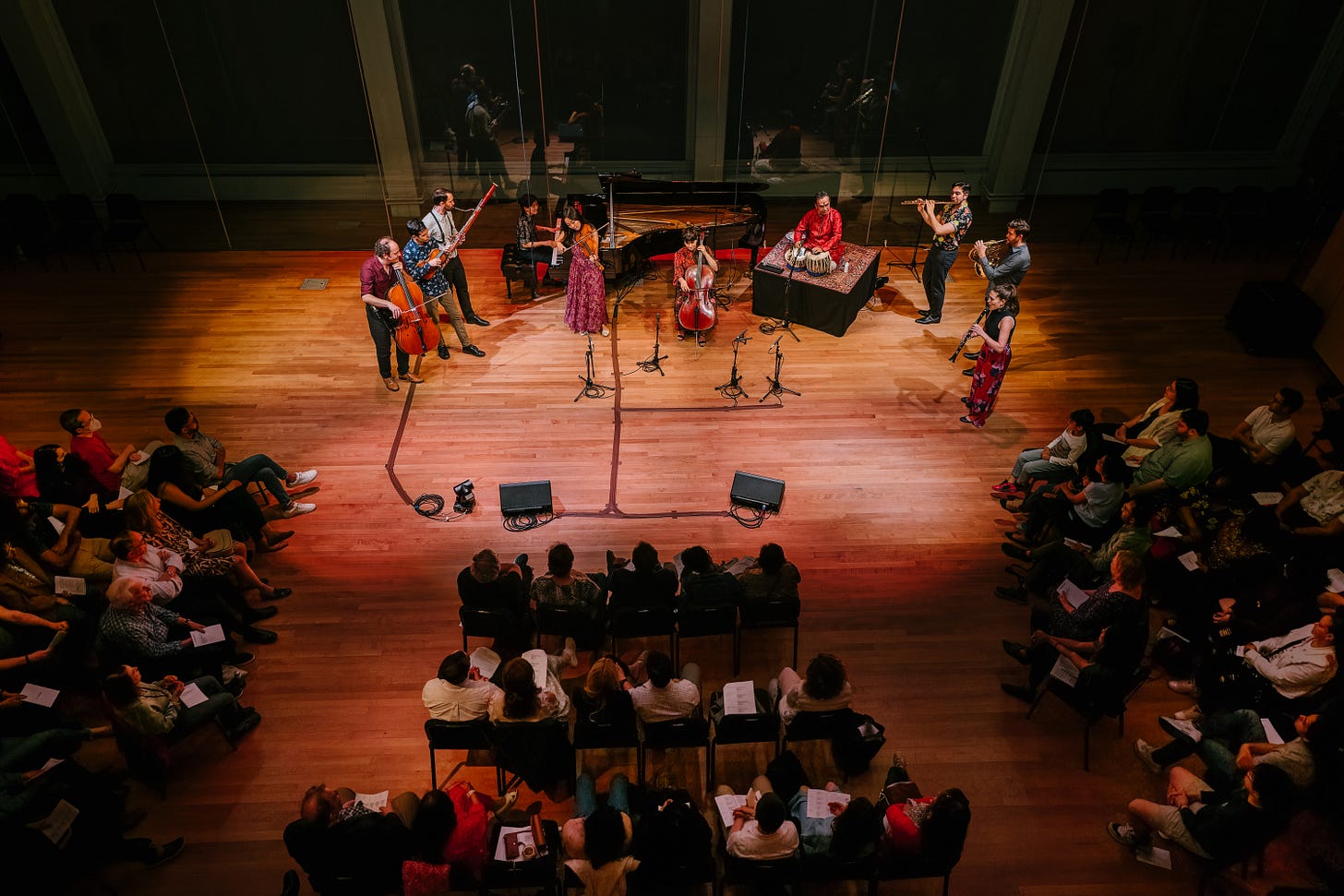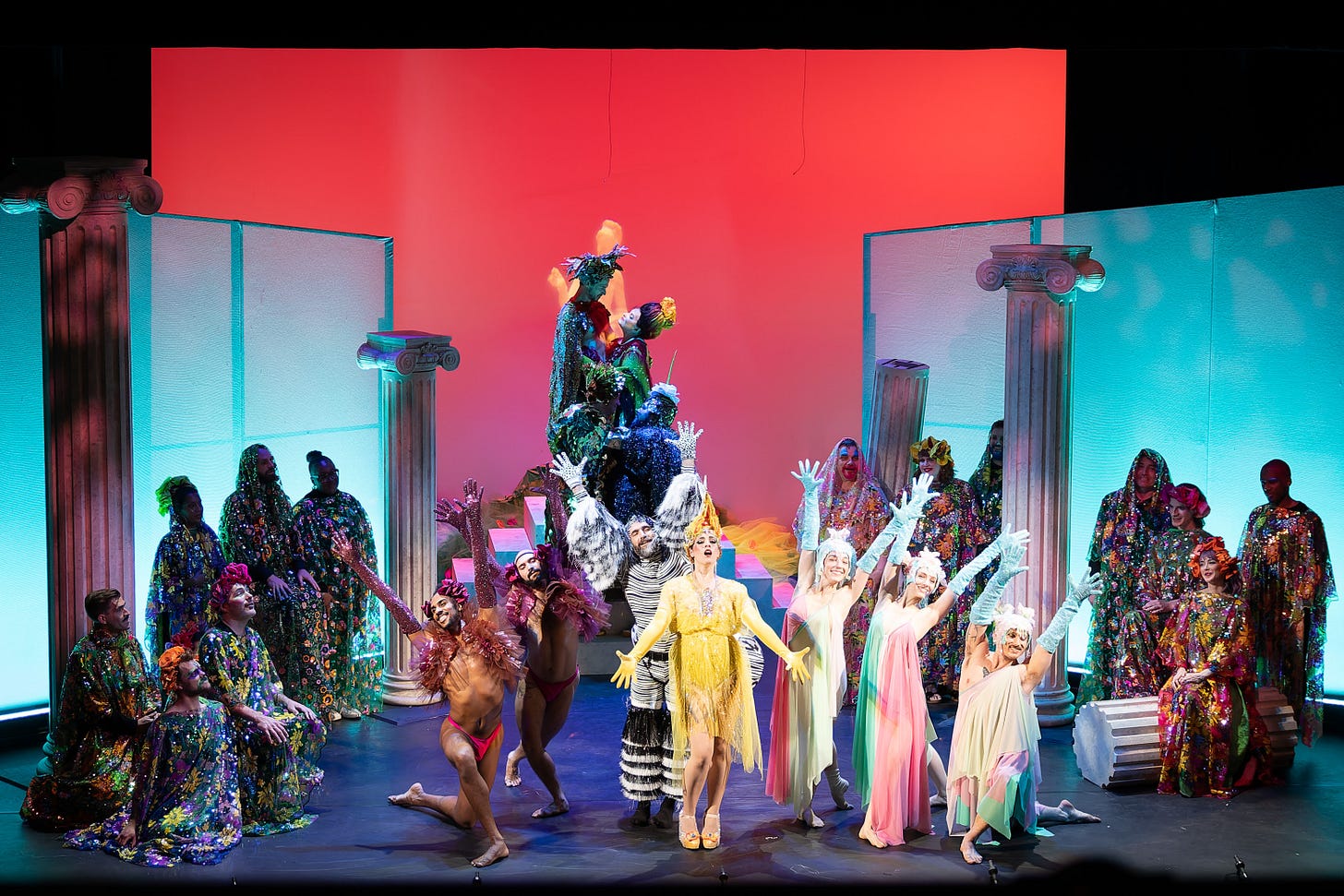Up Close and Personal
On Monday, May 8, I was lucky to see Sandeep Das, Mike Block, and Ensemble Connect Up Close present “Sangam” at Carnegie Hall.
Ensemble Connect is a two-year fellowship program for young classical musicians. The concert —firmly in the aural tradition, with no music stands in sight — consisted of works by “all living composers.” (Something more unusual than you’d think.)
It started with John Zorn’s “Maspiel,” in which horn player Cort Roberts and cellist Laura Andrade’s solos earned many a “shabash” (or “bravo”) from Das.
I enjoyed Rubén Rengel’s “stanky face” in John McLaughlin’s tense “Luki,” in which the violinist took daring harmonic digressions during his solos.
Mike Block’s “Fight or Flight” was characterized by vocal percussion and imitative glisses.
But a mashup of “Where the Soul Never Dies” with a traditional bhajan was interrupted: “Stop! No recording,” said Das. “Part of our job is to educate people on how to attend concerts.”
Halam Kim, at first shy, enjoyed a plaintive viola solo in Das’s “Vaishnavi.” The piece also highlighted pianist Joanne Kang and bassoonist Nik Hooks.
Indeed, the winds shone throughout. With whooshing sounds in Icelandic “Patana Sunset,” and Yasmina Spiegelberg’s tender, sad clarinet melody in Das’s “Tarang”
Flutist Amir Farsi’s was delightfully sassy in Hermeto Pascoal’s “Forró Brasil,” which also saw the debut of Das’s “Brazilian bluegrass tabla.”
The concert ended with “Resham Firiri,” a Nepalese tune playing on mountain echoes.
Queerococo
On Tuesday, May 9 — surrounded by el Museo del Barrio’s storybook murals — Opera Lafayette performed two premieres. That’s right, premieres.
The works were Pierre de La Garde’s Léandre et Héro and Jean-Philippe Rameau’s Io. Neither composer was in the audience.
However, someone just as important was there. Machine Dazzle — the drag mastermind behind Io’s costumes — could be seen noticeably chewing gum during the bows.
In the program notes, Melissa Hyde and Mark Ledbury’s write about Rococo’s relationship to camp, in terms of its “aesthetics of excess” and eroticism.
Indeed, Léandre et Héro’s opened with bearded dancers cavorting gaily in turquoise bodysuits. One carried out the swimming Léandre, sung by Maxime Melnik.
Douglas Williams was commanding as the trident-wielding Neptune. And though Margot Rood was on-call for Emmanuelle de Negri, who was suffering from allergies, she was never needed. Negri sounded stunning as both Héro and, later, Io.
Machine’s costumes for Io, however, made Léandre et Héro’s look like Joann Fabrics. During a rousing overture, each was introduced to audience laughter.
Patrick Kilbride, as Mercure, resembled a rainbow orb with monarch butterfly wing and golden Nikes. Negri, with a flaming red beehive, looked a bit like the villain from The Incredibles.
Melnick, as Apollon, wore a net covered in stuffed fish, later golden New Year’s decorations. The casting showed haut-contre Melnik’s dramatic range: from boy-next-door Léandre to buffoonish Apollon.
Williams, as Jupiter, in a Louis IX-esque crown, sang, “Let our love last as long as the sun continues to rise,” in duet with Negri.
But the ensemble — from Seán Curran Company and the New York Baroque Dance Company — often stole the show.
The turquoise bodysuits from Léandre et Héro reappeared, this time covered in swirling blue tinsel.
The Three Graces — two women and one man in drag — wore cotton candy-colored tunics. Another dancer in zebra print boasted two massive beach balls.
La Folie, sung by Gwendoline Blondeel, appeared in a rainbow tulle gown. Her campy aria about “metamorphosis,” with Queen of the Night-esque high note, earned “bravas” from the crowd.






